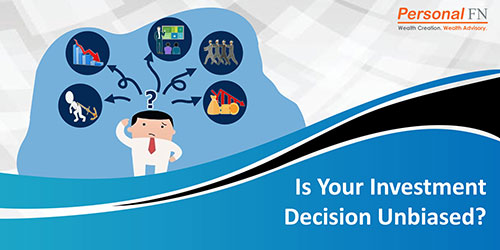How to Overcome Behavioral Biases that Impact Your Investment Decisions
Listen to How to Overcome Behavioral Biases that Impact Your Investment Decisions
00:00
00:00
We make investments to achieve our envisioned short term and long term financial goals. Hence, the investment decisions you make play a significant role in the process of investing. It is essential to analyze various investment avenues to make informed investment decisions and attain your financial goals.
In the past one year, the uncertainties due to COVID-19 pandemic have led many investors toward Do-It-Yourself (DIY) investing. With advanced technology, various apps and portals are offering online investing and financial robo-advisory. These enable investors to chart out their own investment portfolio. As mentioned earlier, a crucial part of the investment process and success is your ability to make effective investment decisions. So carefully consider all aspects when you take the DIY investing approach.
Your investment decisions can be affected by various factors; main one of them is behavioral biases. Many investors are vulnerable to making poor investment decisions based on inaccurate conclusion or emotional reactions to specific financial information. You must be cautious while making investment decisions and avoid behavioral biases to become a successful investor.
The investment biases are either cognitive or emotional; they create behavioral patterns that may influence your investment decision and affect your financial goals. Some of your behavioral tendencies may affect your financial well-being. Behavioral finance focuses on the psychological factors that influence your investment decision and consequentially affect your wealth.
The value investing expert Benjamin Graham mentioned in his book "The Intelligent Investor", "To invest successfully does not require a stratospheric IQ, unusual business insights, or inside information. What's needed is a sound intellectual framework for making decisions and the ability to keep emotions from corroding the framework."
As an investor, it is important to be careful and avoid any dubious investment decisions that could affect your investment journey and potential returns.
Consequently, objectivity and a practical approach towards investing can help you steer away behavioural biases that influence your investment decision and impact your portfolio performance. Even the expert investors are cautious about biases while making any investment decision, but some investors fall prey to irrational decisions due to pre-formed behavioural biases. So, to prevent behavioural biases from affecting your wealth creation journey, build a framework that strengthens your investment decision-making ability.
 (Image source: personalfn)
(Image source: personalfn)
Let us understand the common behavioural biases and ways to overcome them to safeguard your investments from unfavourable investment decisions:
1. Anchoring Bias
Anchoring bias is a phenomenon that indicates the investor's values, an initial piece of information, or could depend on recent information received to make investment decisions. In simple word, while you go for shopping, you simply rely on the price listed of that product and make price comparisons before you decide to buy the product.
When it comes to investing, the investment decisions you make may be vulnerable to anchoring bias and influence buying and selling of your investments. Thus, anchoring bias could influence your investment patterns and lead you to make sub-optimal decisions regarding your investment portfolio.
To overcome the anchoring bias, you should practise critical thinking; this means not relying on or basing your investment decisions on the first information that is available. Instead, take time to conduct thorough research and try to find out any negative points about a fund or product. This will give you a broader view of the entire scheme before you make a decision. The simplest way to prevent anchoring bias is to track investor's behaviour; with practise, you will learn to avoid any anchoring bias.
2. Confirmation Bias
Confirmation bias is cognitive in nature. It is the second most influential bias that may affect your investment decision. Here, investors pay more attention to information supports their views, the tendency to search for, and to adapt to alternate information that might confirm an investor's beliefs.
For example, if an investor is convinced that the small-cap segment will trend upwards, they will only search for information that confirms this while turning a blind eye at the red flags that contradict the information. Investors with this bias have a tendency to overlook the information that warns about a volatility in small caps or highly leverage balanced sheets of companies in that segment.
Confirmation bias can prove to have most costly impact on your investment portfolio, especially when you are invested in high-risk options. In order to overcome this bias, you need to keep information channels open and look for ways that challenge your idea or belief. Seek out the pros and cons for a balanced perspective, as well as alternate information from different sources. Additionally, consider analysing the proposition from multiple perspectives to prevent from falling into the trap of a confirmation bias.

3. Herd Mentality Bias
The term herd mentality happens when an investor follows in the footsteps of other investors and/or the majority when making investments, rather than basing their investment decision on real-time, factual financial data.
The reason investors follow the herd is because it seems comforting and move them along the direction the herd is moving. This bias is also called the 'bandwagon effect' that occurs when some investors mirror investing decisions of another investor.
However, herding may not always assist you to be on the safer side, sometimes investors are unaware if the herd is heading towards a cliff that leads to a steep fall. You may end up making irrational investment decisions that are unsuitable to your portfolio needs.
For instance, in March 2020 lows, the markets crashed and many investors panicked and started liquidating their investments. Some investors joined the herd without considering their own investment objectives and missed out on returns when the markets recovered.
If you keep following the herd, you may not be able to generate optimal returns from your investment portfolio. Investing is an individual exercise. Therefore, every individual must base investment decisions on their risk appetite, investment horizon, and financial goals.
Following the herd mentality will lead you to make unfavourable investment decisions. You must carefully look at investments before taking any step further with the herd. Delve into the hyped investment avenues or assets, company's fundamentals before investing or disinvesting and make informed investment decisions.
4. Loss Aversion Bias
Loss aversion bias is a tendency to be excessively fearful of experiencing losses relative to gains. When it comes to risky investment assets, losses are an inevitable part. Moreover, for new investors, losses are the most unplanned part of their investment strategy.
Due to this loss aversion bias, investors consider low-reward instruments over investments in the equity markets, even if equities are known to provide better returns in long term. Investors with a long investment horizon also tend to have low-risk exposure due to loss aversion bias, which is the fear of losses and the market volatility.
Loss aversion causes you to avoid taking even small risks that can help diversify your portfolio for wealth creation and potential returns in the long run. To overcome this bias, you may not leave it up to the emotion or fear of losses over seeking gains. Construct a robust investment plan as per your suitability and adopt some risk within your tolerance by considering assets that perform well.
5. Overconfidence Bias
Overconfidence bias makes investors overestimate their abilities and knowledge; this can lead to poor investment decisions. Overconfidence is an emotional bias; it can be harmful towards your investment portfolio, as you may make decisions under this bias without analysing the market scenario.
You see, when it comes to investing skills, overconfidence bias can lead investors to believe they can accurately time the market and hence, make investment decision based on that. As markets are unpredictable, you may not be able to time the market and this could lead to underperformance in your portfolio due to these wrong investment decisions.
In order to overcome the overconfidence bias, ensure that you make informed investment decisions after the fundamental and technical analysis of the assets. If you are a new investor, consider consulting a financial professional and discuss your investment strategy, rather than being the wolf of Wall Street. Instead of timing the market and making investments, you may consider the passive investing approach.
Your investment decisions are influenced by various factors including these behavioural biases, which can cause financial errors. If you are aware about such biases and learn how to overcome them, you may be able to construct a robust investment portfolio and make sound investment decisions.
On the other hand, another reason many investors have behavioural finance biases that influence their investment decisions is the lack of financial literacy. Financial knowledge helps you become financially aware and make informed investment decisions. After all, you will have a better understanding of these five biases if you are financially literate. For successful investment decision making, you must understand your behavioural biases and mitigate the risk on your investment portfolio.
It is time to empower yourself with the weapon of financial knowledge and become your own financial planner.
PS: PersonalFN understands that not everyone holds the adequacy of financial knowledge. Here we encourage you to gain and enhance your financial knowledge and become a 'Financial Guardian'. You will understand the financial planning elements to become your own financial planner and guide your family through these challenging times.
If you want to know how you can become that financial guardian for your family, PersonalFN's latest special initiative, the "Certified Family Guardian" offers you an exclusive opportunity to learn the finer nuances of money management.
Organised into eight modules with 24 extensive videos, the "Certified Family Guardian" will help you with relevant tools and learning modules needed to get better at money management. It also offers a host of other benefits to help you make informed investment decisions. Read here for complete details.
So, if you wish to improve your financial knowledge and avoid making any investing mistakes, enrol to "Certified Family Guardian" course today!
Frequently Asked Questions (FAQs)
➢ What is DIY investing?
Do-it-yourself investing is an investment approach where investors adopt a strategy to construct and manage their own investment portfolio instead of depending of a financial professional. Here, investors perform their own investment decisions and make investments accordingly.
➢ What are behavioral biases?
Behavioral biases are irrational beliefs that influence an investor's decision-making process. It consists of psychological factors that influence investors decisions based on how they interpret and act on specific information.
➢ How are these behavioral biases categorized?
The behavioral biases can be categorized as cognitive and emotional biases. While some biases are cognitive in nature such as confirmation bias, anchoring bias etc., others are emotional biases such as loss aversion bias, overconfidence bias etc. Emotional biases tend to result from intuition, reasoning influenced by feelings.
➢ How behavioral biases affect investment decisions of an investor?
Investors fall prey to several behavioral biases and make influenced investment decisions that affect your investment portfolio. In case of the herd mentality bias, investors tend to mimic other investors and follow the herd by making investments in similar assets, even if it is unsuitable as per their investment objectives.
➢ How behavioral biases create risk for an investor?
The complexity of behavioral biases affects the investor's decisions and leads their portfolio exposure to high risk. For example, overconfidence bias may lead an investor to make investment decisions, which are beyond their risk tolerance.
Warm Regards,
Mitali Dhoke
Jr. Research Analyst
Join Now: PersonalFN is now on Telegram. Join FREE Today to get ‘Daily Wealth Letter’ and Exclusive Updates on Mutual Funds